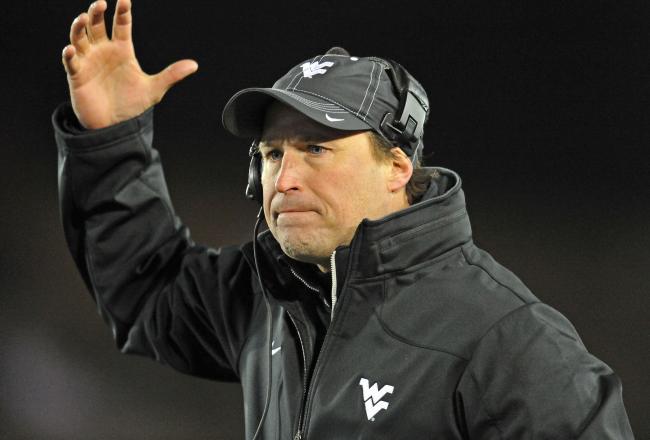Do you remember the days when football programs could just load up on local, home-grown talent?
Well, if you’re a Mountaineer football fan it’s been an awful long time since that’s happened, but in the not-too-distant-past coaches from schools such as Miami, USC and Ohio State didn’t have to go any farther than the other side of town to get most of their players.
These days, that’s not necessarily the case.
I looked up some of the other signing-class rosters from around the country this morning and was somewhat surprised by how far many schools are traveling these days to recruit players.
Take Miami, for instance. Despite being surrounded by some of the best football players in the country, the Hurricanes only managed to sign six Florida players this year. In fact, Miami’s roster of 2013 prospects was comprised of 10 different states (I realize pending sanctions on the Hurricane football program likely played a role in this).
Oregon, which has become one of the most popular football programs in the country, signed only three home-state players this year. The Ducks covered nine different states to piece together their 18-player recruiting class, going as far away as New Jersey to recruit an offensive lineman and North Carolina to sign a kicker.
A quick check of this year’s Rivals.com list of the top recruiting schools from the six power conferences shows one common trait: many of them are covering a lot of territory to get their players. Defending national champion Alabama had the No. 1 recruiting class in the country and Coach Nick Saban had to go to 13 different states to do so. Incidentally, the Tide took just seven players from the state of Alabama this year.
Ohio State, which is located in one of the most fertile states in the country for high school football talent, signed 11 players from the Buckeye State, but also went to 10 other states to secure its 24-member recruiting class, rated the best in the Big Ten.
Pitt had the top recruiting class in the Big East by going to nine different states to sign players; the Pac 12’s top recruiting school, UCLA, landed players from seven different states while Oklahoma and Florida State, the top recruiting schools in the Big 12 and the ACC respectively, needed six different states to wrap up their classes.
Even programs such as Rutgers and Virginia Tech, which have traditionally placed a big emphasis on signing home-grown players, traveled to multiple states to fulfill their recruiting needs.
I only mention this because I thought it was interesting that West Virginia’s 2013 football signing class was made up of prospects from 15 different states. In reality, though, what the Mountaineers did this year is not that unusual in college football these days.
For many years, West Virginia coaches traveled to other states to recruit football players because the Mountain State has annually struggled to produce Division I-caliber talent. The bordering states and Florida have typically served as recruiting “sweet spots” for the Mountaineers, to borrow a phrase WVU Director of Athletics Oliver Luck used yesterday.
While that is still the case, West Virginia coaches are also covering greater distances to locate guys good enough (and willing) to play for the Mountaineers. Considering the fact that Pittsburgh International Airport is no longer a hub, WVU coaches are away from campus now for longer amounts of time changing airports to get to their final destinations – that is if they don’t have access to a private airplane.
“It’s not easy to get anywhere,” West Virginia coach Dana Holgorsen said Wednesday afternoon. “We would get back from recruiting weekends and then hit the road again. When you get a kid like (junior college linebacker) d’Vante Henry, who is from Oklahoma and played in Arizona, that is a lot of traveling to do. It takes a lot of time and money to get those kids.”
Considering the vast number of games now televised nationally, and the conference swapping that appears to be a still on-going process, I’m not so sure high school football players are as married to the notion of playing for local schools as they once were.
That could be beneficial to programs like West Virginia which must travel great distances to stock its roster.
Everyone around here remembers former Pitt coach Dave Wannstedt wanting to build a wall around the city of Pittsburgh to keep other schools from stealing the top WPIAL players. That remark didn’t sit too well in Morgantown when Rich Rodriguez was coaching the Mountaineers.
And there are many Mountaineer fans convinced that West Virginia should place a renewed emphasis on recruiting Western Pa players today – I know this because I read it frequently on twitter and Internet message boards.
My question is why?
According to longtime Pittsburgh Post-Gazette high school writer Mike White, a whopping 18 WPIAL players signed with Division I football programs this year. Of those 18, just 11 were signed by high-major programs – seven going to Pitt, two to West Virginia and one each to Alabama and Michigan.
In Pitt’s case, the Panthers took two other players from small-school power Clairton to make sure they secured the signature of touted wide receiver prospect Tyler Boyd. Perhaps Boyd’s teammates were good enough to play for Pitt, but it does make you wonder.
The decline in WPIAL talent seems to be a growing trend, too. Two years ago, WPIAL schools produced only 21 Division I football players. According to White, this year’s crop “has to be the lowest ever – or at least in the past 50 years,” he wrote yesterday in his high school blog.
That’s certainly not an encouraging sign for local schools wanting to build walls around their city. And if that trend continues, West Virginia coaches may be looking at even more time on the road in the future.






























